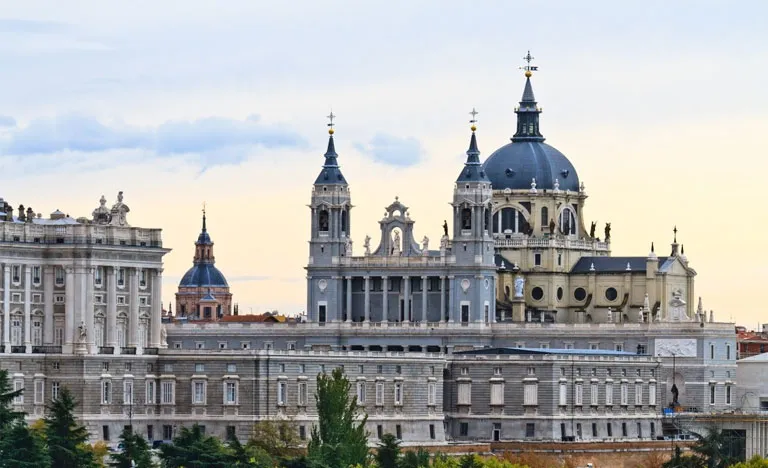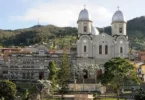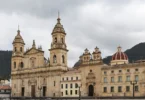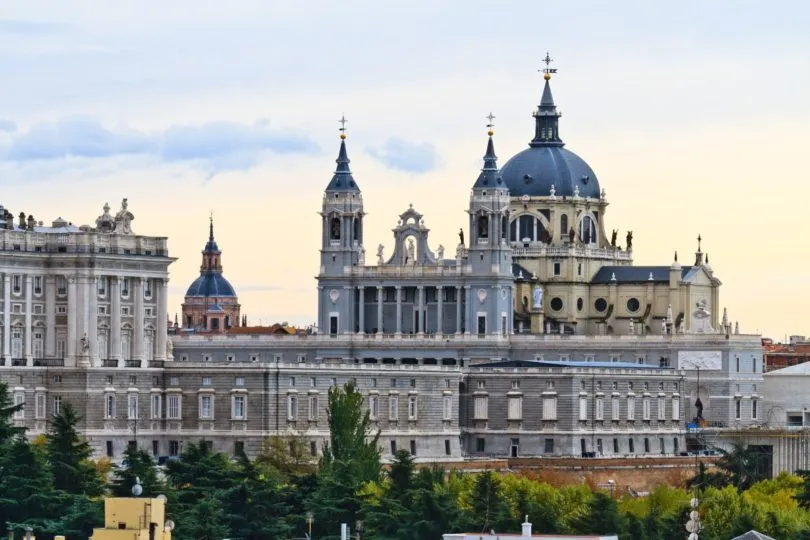
Introduction
The Cathedral of Santa Maria la Real de la Almudena, known as the Almudena Cathedral, is for many an architectural jewel, while for others; it is an eclectic-style construction with a mixture of styles and periods. Madrid, the dynamic capital of Spain, is a city that consistently mixes history and innovation. Among its numerous compositional marvels, the Cathedral de la Almudena remains as a demonstration of the city’s rich social and strict legacy. This heavenly church, with its sensational design and significant history, coaxes guests to investigate its greatness and submerge themselves in the profound and social embroidered artwork of Madrid.
The Almudena Cathedral is one of the most impressive religious monuments in Madrid. Its characteristic neo-Gothic style stands out in comparison to other cathedrals of the same style. Moreover, its dimensions and majesty leave anyone who visits it speechless. The cathedral was consecrated by Pope John Paul II in 1993.
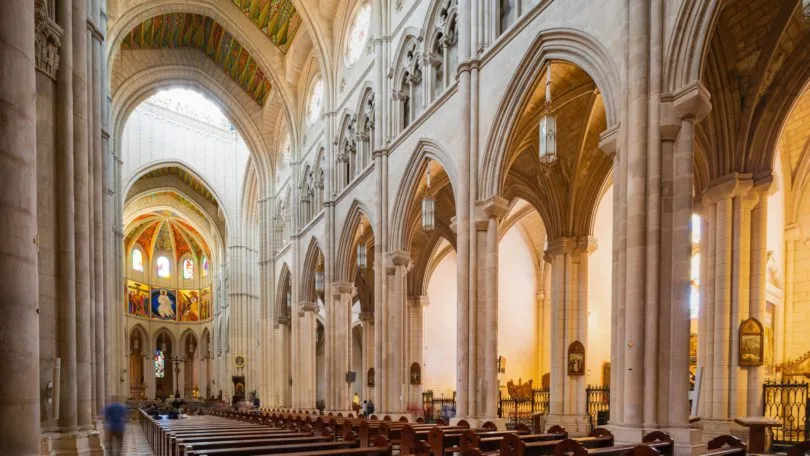
Madrid’s cathedral, the Cathedral de la Almudena, has a short but tortuous history. Plans for a cathedral dedicated to the Virgin of Almudena were discussed in the 16th century, but the cost of expanding and keeping the Empire took precedence, so construction was postponed.
The first plans for the church were drawn up in 1879 by Francisco de Cubas, who envisioned a pantheon for the late Queen Maria de la Mercedes. The foundation stone was laid in 1883. However, when Pope Leo XIII granted a bull in 1885 for the creation of the Madrid-Alcalá bishopric, the plans for the church had to change, and it was transformed into a cathedral.
Cubas created a new project inspired by French 18th-century Gothic, adding elements from the cathedrals of Reims, Chartres, and León. The project was highly ambitious, including a large Romanesque crypt, and it served as the basis for the final construction.
The cathedral was supposed to be a votive temple erected by the people, but the donations were insufficient, and many delays and setbacks ensued. In 1899, the Marquis of Cubas died, and other architects, Miguel Olabarría, Enrique Maria Repullés, and Juan Moya, were subsequently put in charge of the project. The crypt was opened in 1911, but work was suspended during the Spanish Civil War and resumed with limited resources in 1939.
After the war, aesthetic criteria had changed, and a Gothic cathedral was no longer considered suitable because of the contrast with its surroundings. In 1944, Fernando Chueca Goitia and Carlos Sidro won a national contest to find a new architectural solution. The baroque exterior of the cathedral today matches the grey and white façade of the adjacent Palacio Real.
Work resumed in 1950, after 110 years of extensions and modifications, the construction of the Almudena Cathedral was completed on 15 June 1993. Nowadays, it is one of the most important religious temples in Madrid, with an incredible architectural and ornamental wealth both in its façade and interior. The cathedral was finally consecrated by Pope John Paul II on his fourth trip to Spain in 1993.
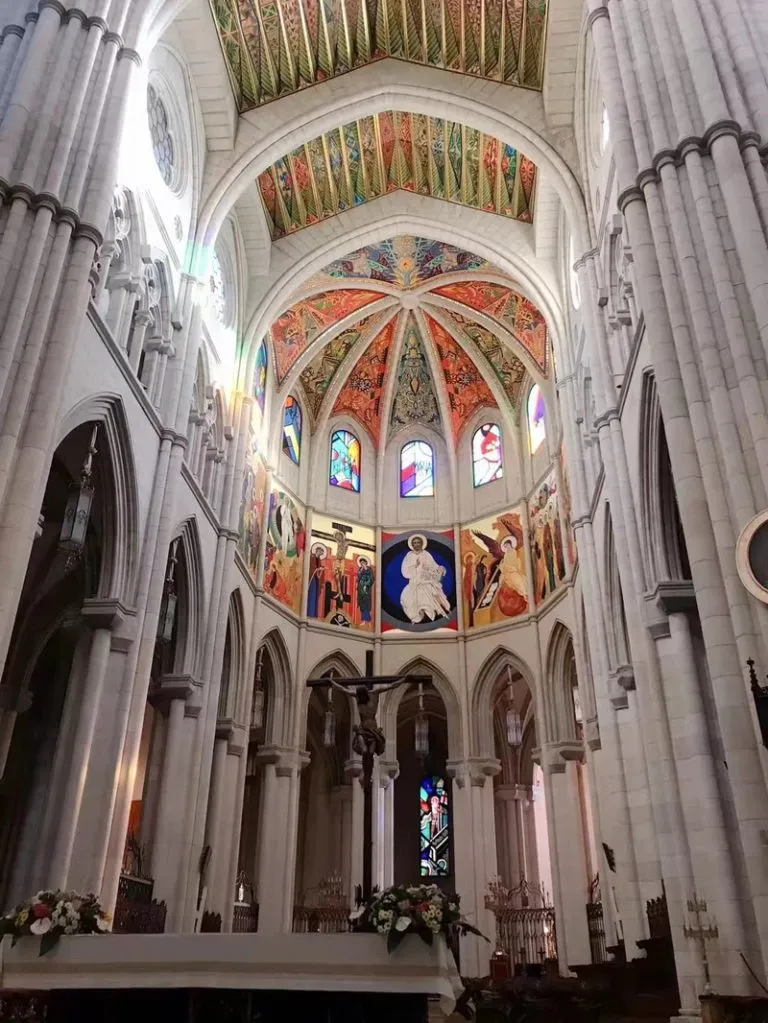
Nestled in Colmenar Viejo, this church, spanning 102 meters in length and 12.5 meters in nave width, is a harmonious blend of Colmenar Viejo granite and Novelda marble. The enduring strength of granite and the elegant allure of marble converge, creating a sacred space that seamlessly integrates natural elements into architectural magnificence
The Cathedral de la Almudena in Madrid boasts an impressive and eclectic mix of architectural styles. The exterior design showcases a combination of neoclassical, neo-gothic, and neo-romanesque styles, resulting in a magnificent and unique facade. The gray and white facade of the Palacio Real, located directly opposite the cathedral, influenced the exterior design.
The Marquis of Cubas designed a large cathedral, in a flowery French neo-Gothic style, with a Latin cross plan and side chapels that would be directly connected by a narrow ambulatory; The transept would also have three naves while the apse would be semicircular with an ambulatory and five radial chapels. The image of the Almudena would be placed on the main altar.
The crypt was completed in 1911, but the marquis had already died; He was succeeded in leading the works by the architects Miguel Olabarría, Enrique Repullés y Vargas and Juan Moya. The work progressed very slowly, with the logical pause occurring between 1936 and 1939. In 1944, the general director of Fine Arts, Marquis of Lozoya, promoted a national competition to give the cathedral a new architectural solution. The architects Fernando Chueca Goitia and Carlos Sidro won the project and modified it to adapt it to the environment.
In 1944, the general director of Fine Arts, the Marquis of Lozoya, promoted a national competition to give the cathedral a new architectural solution. The architects Fernando Chueca Goitia and Carlos Sidro de la Puerta won the project and modified it to adapt it to the environment. The most important reform was to lower the height of the new building in order to make it more harmonious in relation to the Royal Palace.
During the period from 1984 to 1993, other important works were carried out, such as the complete paving of the temple with cream and green marble from Almería, forming simple drawings, but with great visual impact. Also, the presbytery was ordered according to models of the new liturgy, inspired above all by the latest reforms of the Milan cathedral.
The altar of the Virgin of Almudena was also created, with a scenography that exalted the dignity of the image incorporated into a beautiful altarpiece by Juan de Borgoña. Likewise, works were carried out in some chapels and underfloor radiant heating installations were carried out; lighting with spotlights and protectors appropriate to the environment, as well as the installation of public address systems.
Inside, the Almudena Cathedral has a Latin cross plan with a central nave and two side naves and a three-nave transept, topped on one side by the titular chapel. The floor of this temple is a combination of green serpentine marble from Granada and yellow polished travertine; the altar table has also been made of green serpentine marble. To its right is the episcopal chair, carved in walnut, in a neo-Gothic style, a work made by Ramón Fonollosa in 1885.
Behind the main altar is the Crucified Christ by Juan de Mesa commissioned by the Imperial College of Madrid and which, like the choir stalls, located on both sides of the altar, comes from the collegiate church of San Isidro.
In the presbytery of the cathedral the seven mysteries of our salvation are represented: Baptism of Jesus, the Transfiguration, the Death, the Resurrection, the Ascension to heaven and Pentecost. In the centre, presiding over the composition, the image of Jesus Pantocrator. The work of this presbytery was directed by Kiko Argüello, initiator of the Neocatechumenal Way. He also made the eight stained glass windows that accompany it. The entire set makes up the so-called mystery crown.
Behind the ambulatory stands out the central chapel dedicated to Saint Isidro Labrador and his wife, Saint María de la Cabeza. The baroque-style images of both saints (17th and 18th centuries) are attributed to Villabrille and Ron and flank the funerary ark that contained the incorrupt remains of the saint, which are currently found in the collegiate church of San Isidro. This ark, from the 13th century, presents scenes from the life of Saint Isidro painted in oil on coated leather. On the side of the ambulatory you can see an altarpiece by Domingo Becerrill, Berruguete’s son-in-law, relating to the life of Saint Peter. Under the altarpiece, the Almudena stele made by the silversmith Manuel Carrera in 2011 and funded by the Villa y Corte Foundation. The rest of the chapels are dedicated to contemporary saints, from Madrid or related to the city.
The chapel of the Blessed Sacrament was decorated with mosaics in 2011 by Father Ivan Marko Rupnik, SJ, head of the Aletti Center art workshop. The type of art he develops is eminently liturgical. He was also in charge of the decorations of the main sacristy and the chapter house, carried out in 2005 and 2006, respectively.
Of great value is a Via Crucis with fourteen stations that respond to the Flemish neo-Gothic style and that would have been made at the end of the 19th century, of German origin; It is made in oil on copper and its frame is made of hand-decorated chestnut wood. As for the stained glass windows, the ones dedicated to the Virgin of Atocha, Saint Isidro the Labrador, the Coronation to the Virgin of the Fleur de Lis, and the Angels stand out.
On the main façade, the belfry stands out with sculptures by Ramón Chaparro: Saint Isidro, Saint María de la Cabeza, Saint Fernando and Saint Teresa of Jesús flank an image of the enthroned Virgin of Almudena. The shields at the bottom of the façade represent the full arms of the Spanish Royal House and the pontifical shield.The doors, like the sculptures located in the dome, are the work of Luis Sanguino.
Crypt
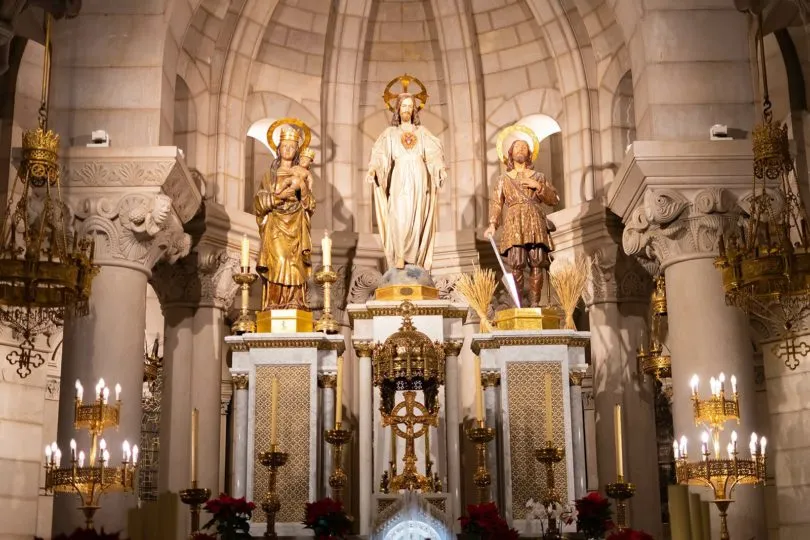
Under the Almudena Cathedral is the crypt designed by Francisco de Cubas. It is an all-stone construction with a quarry vault with 558 columns, 50 of them monolithic. All the capitals are different and carved. The crypt is full of family graves, among them those of the two most significant architects of the cathedral, the Marquis of Cubas himself and Chueca Goitia. The main altar is presided over by an image of the Virgin of Almudena from 1948.
The oldest image of Mary in Madrid is preserved in the crypt: the Virgin of the Fleur de Lis, which comes from the primitive church of Santa María. It is a mural painting that was discovered in 1623, when Kings Felipe IV and Isabel de Borbón were going to go to the Church and the sacristans moved the altarpiece to clean it.
Dated in the 12th-13th century, it shows us a mural painting of the Virgin as the throne of the Savior with a fleur-de-lys in her hand and, under her feet, with a red cross, remembering the collaboration of the Order of Calatrava in the reconquest of the town.
Almudena Cathedral Museum
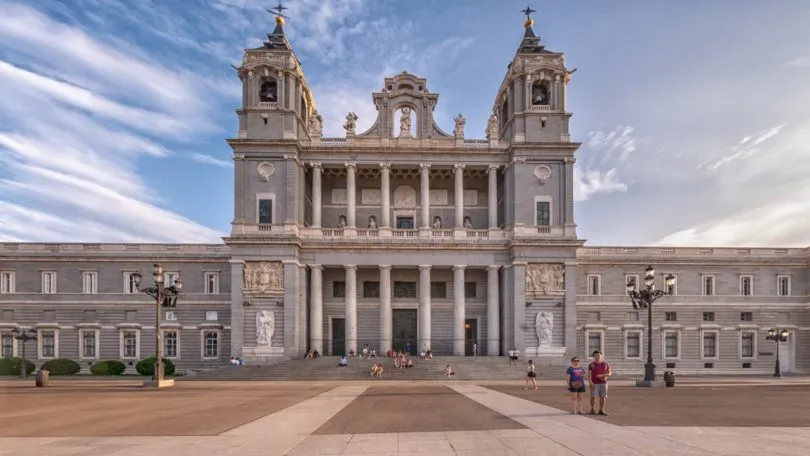
Since 2000, the Cathedral Chapter of Madrid has envisioned the creation of a Museum of the Cathedral to showcase its history and chapter assets. The initiative began with the inventory conducted in 1993, revealing a collection of valuable ornaments, particularly goldsmithing. Some assets were recovered post-1939, while others came from the “general reparations fund” and various donations
Despite challenges, historical ornaments, metalwork, and documents about the Virgin were gradually recovered, notably from the congregations of the Virgin founded in the 17th and 20th centuries.
The museum, as a window into the history and life of the Diocese and the Virgin of Almudena, serves a didactic and catechetical purpose. Each exhibited piece, including valuable works of art like the 13th-century “Codex of Juan Diacono,” holds real value for its representation or the reason it was acquired. The museum aims to educate visitors about the Diocese, the Bishop, the Patroness, San Isidro, the Patron, and everything related to liturgy and sacraments.
The museum is envisioned as a “living” space, where each piece conveys a message, and even when on display, it continues to serve its intended purpose. Ultimately, the museum acts as a precursor to the possibility of a diocesan museum in the future, showcasing the heritage of the diocese for public admiration and understanding.
In 2007, the Almudena Cathedral Museum was inaugurated, which preserves and exhibits pieces from the Cathedral Chapter and Congregation deposits. Several pieces of incalculable artistic, historical and religious value are exhibited in the museum.
Notable burials
More numbr of people are buried at Almudena Cathedral. To name them few are here.
- Her Majesty Mercedes of Orléans, Queen of Spain (1860–1878)
- His Highness Prince Ferdinand of Bavaria (1884–1958)
- His Highness Jose Eugenio, Prince of Bavaria (1909–1966)
- His Highness Luis Alfonso, Prince of Bavaria (1906–1983)
- Her Highness Doña María de la Asunción Solange de Mesía y de Lesseps, Princess of Bavaria and Countess of Odiel (1911–2005)
- Carmen Franco, 1st Duchess of Franco (1926–2017)
- Cristóbal Martínez-Bordiú, 10th Marquess of Villaverde (1922–1998)
- Francisco de Cubas, I Marquess of Cubas (1826–1899)
- Francisco de Cubas y Erice, II Marquess of Cubas, II Marquess of Fontalba and Grandee of Spain (1868–1937)
- Estanislao de Urquijo y Landaluce, I Marquess of Urquijo (1817-1889)
- Estanislao de Urquijo y Ussía, III Marquess of Urquijo (1872-1948)
- Isabel de Maltrana y de Novales, I Marquise de Maltrana (d. 1919)
- Luis de Pedroso y Madan, V Count of San Esteban de Cañongo (1876-1952)
- María Dolores de Pedroso y Sturdza, VI Countess of San Esteban de Cañongo
- Margarita de Pedroso y Sturdza, VII Countess of San Esteban de Cañongo (1911-1989)
- Cardinal Ángel Suquía Goicoechea (1916–2006)
- Fernando Rielo Pardal (1923–2004)
- Alfonso Peña Boeuf (1888–1966)
Enrique María Repullés (1845–1922)
Madrid's Fiesta de la Almudena
One of the central events of Madrid’s Fiesta de la Almudena is the traditional floral offering in the Plaza de la Amudena, which takes place on the eve, 8 November. During this event, the people of Madrid bring flowers and non-perishable foodstuffs which are then donated.
On the 9th, the High Mass takes place at 11 am in the Plaza de la Almudena, between the Almudena Cathedral and the Royal Palace, presided over by the Archbishop of Madrid. After the ceremony, the Procession of the Virgin begins through the streets of Madrid, which runs through the centre of the capital until it returns to the cathedral.
Feast Day
The annual feast day of the Cathedral de la Almudena is celebrated on 9th November
Mass Timing
Monday to Saturday
- 12:00 noon
- 06.00 pm
- 07.00 pm
Sunday(Spanish)
- 10:30 am
- 12:00 noon
- 01:30 pm
- 06.00 pm
- 07:00 pm
Confessions (everyday)
- 11:00 am – 04:00 pm
- 05:00 pm – 08:00 pm
Contact Info
Calle Bailen 10, 28013, Madrid
Phone No.
Phone: (+34) 915 422 200
Accommodations
How to reach the Sanctuary
Airways
The nearest Airport to Cathedral de la Almudena is Madrid Airport (MAD) which is just 13 kms away from the Cathedral. The road distance is 23.2 km.
Railways
The nearest Railway station to Cathedral de la Almudena is Príncipe Pío. which is just 14 mins walk from the Cathedral.

